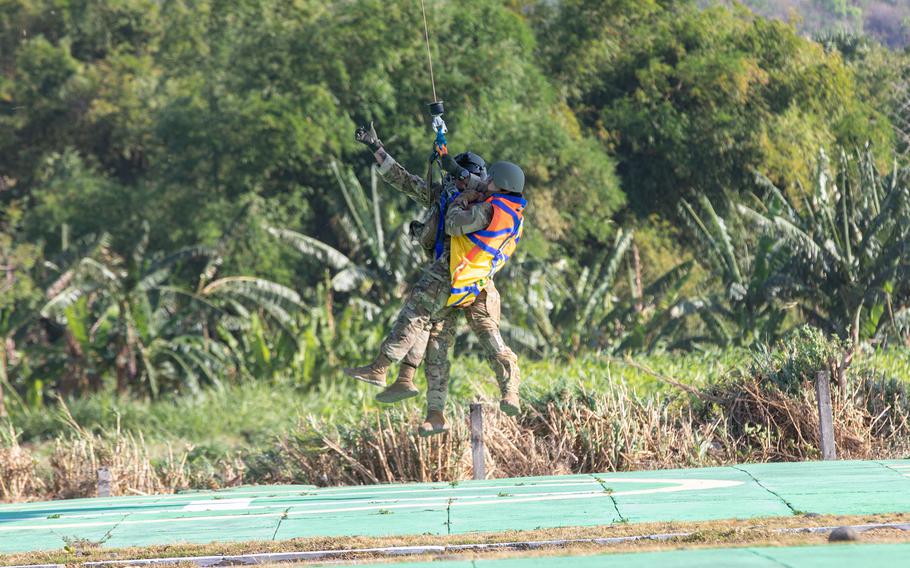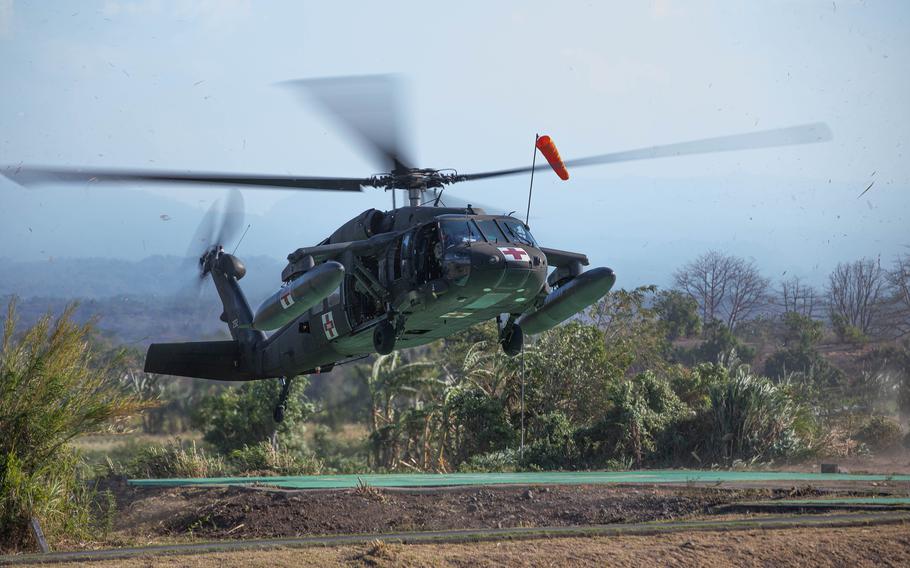
U.S. soldiers from the 16th Combat Aviation Brigade, 7th Infantry Division conduct medical evacuation training during the Super Garuda Shield exercise in Puslatpur, Indonesia, Aug. 30, 2023. (Wyatt Moore/U.S. Army)
The United States and Indonesia are conducting more complicated drills as part of an expanded version of an annual exercise that this year includes forces from Australia, Japan, Singapore, France and the United Kingdom.
Super Garuda Shield, which runs in East Java until Sept. 13, involves 5,000 troops from the seven nations and observers from a dozen other countries, according to New Zealand army Col. Paul Hayward, a deputy commander with the U.S. 25th Infantry Division, which has provided most of the American soldiers for the exercise.
“This year we are seeing really significant expansion, not only across participating nations … but, in the breadth and complexity of the training we are conducting across Indonesia,” Hayward said by phone Thursday from Puslatpur Marine Base, East Java.

U.S. soldiers from the 25th Infantry Division and Australian troops conducted medical evacuation training during the Super Garuda Shield exercise in Puslatpur, Indonesia, Aug. 30, 2023. (Wyatt Moore/U.S. Army)
Last year’s Super Garuda Shield involved 4,000 U.S. and Indonesian troops training mostly on Sumatra. Its organizers called it the largest ever in the exercise’s 16-year history.
It included an amphibious operation near a key gateway to the South China Sea, where China has territorial claims that Indonesia does not recognize. The two nations have clashed over fishing rights in recent years.
Indonesia’s Natuna Islands, northeast of Singapore, are close to a part of the South China Sea claimed by China. However, Hayward said none of this month’s Super Garuda Shield training will take place near that area.
U.S. forces involved in the drills include the amphibious transport dock USS Green Bay from Sasebo Naval Base, Japan; aircraft from Pacific Air Forces; National Guard troops from Oklahoma, California and Florida; and members of the U.S. Marine Rotational Force - Darwin deployed to Australia’s Northern Territory, Hayward said.
“Super Garuda Shield 2023 builds on last year’s tremendous success,” Gen. Charles Flynn, U.S. Army Pacific’s commander, said in a statement posted Tuesday by the U.S. Embassy in Jakarta. “This joint, multinational training exercise displays our collective commitment and like-minded unity, allowing for a stable, secure, and more peaceful, free and open Indo-Pacific.”
Australia has deployed M1 Abrams tanks to Indonesia to join the drills for the first time, Hayward said.
The training will include rapid insertion of a U.S. Army High Mobility Artillery Rocket System, or HIMARS, onto an airfield, an amphibious landing involving U.S. Marines, and an airborne operation involving paratroopers from the U.S. Army’s 11th Airborne Division.
There will be a multinational live-fire event at Puslatpur on Sept. 11, Hayward said.
Nations observing the exercises include Brunei, Brazil, Canada, Germany, India, Malaysia, Netherlands, New Zealand, Papua New Guinea, Philippines, South Korea and Timor Leste, according to the embassy statement.
The expanded exercise in Indonesia mirrors what’s happening across the Western Pacific, according to Paul Buchanan, an American security expert based in New Zealand.
“It is clear that there has been an increase in both the number of exercises as well as the number of participants in them, including some who have not participated in such exercises before,” he said by email Friday. “The size and tempo of the exercises has increased, as has the complexity of the operations conducted within them.”
The training sends a clear message to hostile actors in the region that there is common resolve, improved professionalism, and increased coordination between regional security partners, Buchanan said.
“That should give would-be adversaries pause when contemplating the use of force in the region, if not deter them from behaving aggressively in specific instances,” he said.